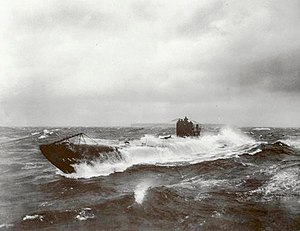SM UB-109
 UB-148 at sea, a U-boat similar to UB-109.
| |
| History | |
|---|---|
| Name | UB-109 |
| Ordered | 6 / 8 February 1917[1] |
| Builder | Blohm & Voss, Hamburg |
| Cost | 3,714,000 German Papiermark |
| Yard number | 315 |
| Launched | 7 July 1917[2] |
| Commissioned | 31 December 1917[2] |
| Fate | Sunk by mine on 29 August 1918 at 51°3′N 1°44′E / 51.050°N 1.733°E[2] |
| General characteristics [2] | |
| Class and type | Type UB III submarine |
| Displacement | |
| Length | 55.30 m (181 ft 5 in) (o/a) |
| Beam | 5.80 m (19 ft) |
| Draught | 3.70 m (12 ft 2 in) |
| Propulsion |
|
| Speed |
|
| Range |
|
| Test depth | 50 m (160 ft) |
| Complement | 3 officers, 31 men[2] |
| Armament |
|
| Service record | |
| Part of: |
|
| Commanders: |
|
| Operations: | 3 patrols |
| Victories: |
7 merchant ships sunk (14,092 GRT) |
SM UB-109 was a German Type UB III submarine or U-boat in the German Imperial Navy (German: Kaiserliche Marine) during World War I. She was commissioned into the German Imperial Navy on 31 December 1917 as SM UB-109.[Note 1]
UB-109 was sunk by mine in the English Channel on 29 August 1918[2] and underwater scanning of the area covered by the Dover Barrage shows her wreck broken in half.[4]
Construction
[edit]She was built by Blohm & Voss of Hamburg and following just under a year of construction, launched at Hamburg on 7 July 1917. UB-109 was commissioned later the same year under the command of Oblt.z.S. Kurt Ramien. Like all Type UB III submarines, UB-109 carried 10 torpedoes and was armed with a 8.8 cm (3.46 in) deck gun. UB-109 would carry a crew of up to 3 officer and 31 men and had a cruising range of 7,420 nautical miles (13,740 km; 8,540 mi). UB-109 had a displacement of 510 t (500 long tons) while surfaced and 629 t (619 long tons) when submerged. Her engines enabled her to travel at 13.3 knots (24.6 km/h; 15.3 mph) when surfaced and 7.4 knots (13.7 km/h; 8.5 mph) when submerged.
Summary of raiding history
[edit]| Date | Name | Nationality | Tonnage[Note 2] | Fate[5] |
|---|---|---|---|---|
| 9 April 1918 | President Leroy-lallier | 1,320 | Sunk | |
| 10 April 1918 | Henley | 3,249 | Sunk | |
| 13 April 1918 | Wilson | 110 | Sunk | |
| 18 April 1918 | Runswick | 3,060 | Sunk | |
| 19 August 1918 | Zinal | 4,037 | Sunk | |
| 25 August 1918 | Pontet Canet | 1,183 | Sunk | |
| 26 August 1918 | Helge | 1,133 | Sunk |
References
[edit]Notes
[edit]- ^ "SM" stands for "Seiner Majestät" (English: His Majesty's) and combined with the U for Unterseeboot would be translated as His Majesty's Submarine.
- ^ Tonnages are in gross register tons
Citations
[edit]- ^ Rössler 1979, p. 66.
- ^ a b c d e f Gröner 1991, pp. 25–30.
- ^ Helgason, Guðmundur. "WWI U-boat commanders: Kurt Ramien (Royal House Order of Hohenzollern)". German and Austrian U-boats of World War I - Kaiserliche Marine - Uboat.net. Retrieved 9 March 2015.
- ^ "The Maritime Archaeology of the Dover Barrage". Wessex archaeology on line. Retrieved 1 September 2015.
- ^ Helgason, Guðmundur. "Ships hit by UB 109". German and Austrian U-boats of World War I - Kaiserliche Marine - Uboat.net. Retrieved 9 March 2015.
Bibliography
[edit]- Bendert, Harald (2000). Die UB-Boote der Kaiserlichen Marine, 1914-1918. Einsätze, Erfolge, Schicksal (in German). Hamburg: Verlag E.S. Mittler & Sohn GmbH. ISBN 3-8132-0713-7.
- Gröner, Erich; Jung, Dieter; Maass, Martin (1991). U-boats and Mine Warfare Vessels. German Warships 1815–1945. Vol. 2. Translated by Thomas, Keith; Magowan, Rachel. London: Conway Maritime Press. ISBN 0-85177-593-4.
- Rössler, Eberhard (1979). Die deutschen U-Boote und ihre Werften: eine Bilddokumentation über den deutschen U-Bootbau; in zwei Bänden (in German). Vol. I. Munich: Bernard & Graefe. ISBN 3-7637-5213-7.
External links
[edit]- Scott, G (2015) 'UB-109 off Folkestone, Kent: Archaeological Report', Wessex Archaeology
- Historic England project to research First World War submarines[permanent dead link]
